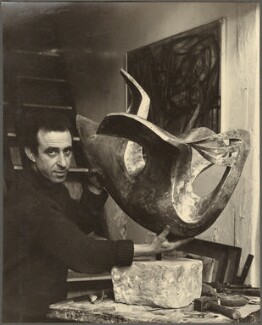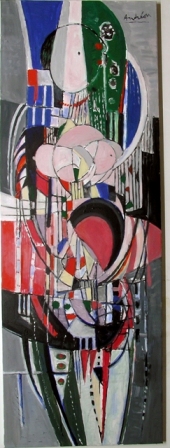Constantine Andreou facts for kids
Quick facts for kids
Constantine Andreou
|
|
|---|---|

Andreou in 1954.
|
|
| Born | March 24, 1917 São Paulo, Brazil
|
| Died | October 8, 2007 (aged 90) Athens, Greece
|
| Known for | Painting, sculpture |
|
Notable work
|
Globe – Trinité (1974) |
| Awards | Gran Prix d' Antoine Pevsner (1988), Croix de Chevalier de la Légion d'honneur (2000), Officier de l'Ordre des Arts et des Lettres (2005) |
Constantine Andreou (born March 24, 1917 – died October 8, 2007) was a famous artist from Brazil. He was a talented painter and sculptor whose career lasted for over 60 years! Many people think he was a very important artist in the 1900s.
Biography
Early Life
Constantine Andreou was born in São Paulo, Brazil, in 1917. His parents were Greek and had moved to Brazil a few years before he was born.
In 1925, his family moved back to Greece. They lived in Athens until World War II ended. During these years, Andreou enjoyed crafts. He even worked as a carpenter, making furniture. He also studied technical design and graduated in 1935. In the same year, he started studying sculpture. This art form later made him very well known.
In 1939, Andreou entered an art competition called the Panellinio. The judges did not accept his three sculptures. In 1942, he tried again with the same artworks. His sculptures looked so real that he was accused of cheating! People thought he had copied nature directly. Three important Greek artists, Memos Makris, John Miliades, and Nikos Nikolaou, defended him. Because of this, he became famous and his art got a lot of attention.
In 1940, Greece joined World War II. By 1941, the country was under occupation. Andreou joined the Hellenic Army in 1940. During the occupation, he was an active member of the Greek Resistance.
Even with the war, Andreou kept creating art and studying. In 1945, he won a scholarship to go to France. He traveled there with many other Greek thinkers on a ship called the RMS Mataroa.
Life in France
In 1947, Andreou started using a new art method. He used welded copper sheets to create his sculptures. This new way of working helped him express his ideas in a completely new style.
A big influence on Andreou's art was his friendship with Le Corbusier. Le Corbusier was a famous architect. They first met in 1947 and worked together until 1953. Le Corbusier once asked Andreou, "Where did you learn how to work?" Andreou replied, "I'm Greek, I carry the knowledge within me." This friendship taught Andreou to see buildings as huge sculptures and sculptures as following building rules.
Around the same time, Andreou joined a special group of thinkers. They included Jean-Paul Sartre, a famous philosopher. They would discuss many different topics in Saint-Germain-des-Prés, a neighborhood in Paris.
Andreou had his first art show in Paris in 1951. There, he showed how his style had changed. In a group show called "Seven Greek Sculptors," Andreou was called "the most famous Greek sculptor in the capital." By the end of the 1950s, Andreou was well known in the French art world. People saw him as being as important as artists like Mondrian, Picasso, and Gastaud. In 1982, he became the chairman for sculpture at the Paris "Autumn Salon."
In 1999, a library in La Ville-du-Bois, the town where Andreou lived in France, was named after him.
While living in France, he often visited his friends and family in Greece. He also showed his art in many Greek cities and islands. In 1977, Andreou bought a very old winery on the island of Aegina. He turned it into a house. His friend Nikos Nikolaou had encouraged him to buy a house there. In 1985, on Aegina, Andreou created a series of twenty paintings called "Polymorphs." These paintings were inspired by a poem.
Andreou also took part in many international art shows. These included the Biennales in Antwerp, the Netherlands, Paris, Venice, and Yugoslavia.
Later Years and Death
Constantine Andreou moved back to Athens, Greece, in 2002. He passed away on October 8, 2007, at his home in Athens.
Legacy
In 2004, Andreou started the "Costas Andreou Foundation." Its goal is to share his art with the world. It also wants to show how important sculpture and painting are. Every three years, the foundation gives an award to young, new artists. An international group of judges decides who wins. The first award was given in March 2008.
Awards
- Gran Prix d'Antoine Pevsner, 1998
- Croix de Chevalier de la Légion d'honneur, 2000
- Officier de l'Ordre des Arts et des Lettres, 2005
See also
 In Spanish: Constantine Andreou para niños
In Spanish: Constantine Andreou para niños
- Légion d'honneur
- Ordre des Arts et des Lettres
- La Ville-du-Bois


